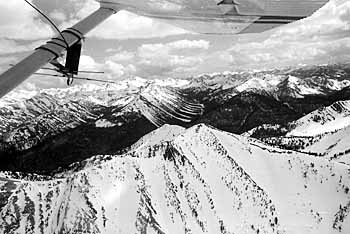Wolf flight
"Beep…beep…beep"—on the trail of the Stanley
pack
By GREG STAHL
Express Staff Writer

Using radio telemetry equipment tucked beneath the wing
of a Cessna, pictured above, to pick up signals from wolves’ radio collars, the Nez
Perce tribe’s wolf researchers can easily track wolf movements. Express photo by
Willy Cook
STANLEY—Through Idaho’s dense timber stands and rugged alpine
terrain, tracking far-wandering gray wolves from the ground would be a formidable task,
but from 12,000 feet with radio telemetry equipment tucked neatly beneath your wings, the
elusive wolf is easily found.
As one of the Nez Perce tribe’s wolf monitoring flights climbed
toward patchy spring clouds on Thursday afternoon, the Stanley Basin’s glacial
moraines diminished below and jagged mountains stretched to the horizons.
The little Cessna 140 climbed at the hands of Stanley pilot Bob Danner
while Idaho’s Nez Perce wolf recovery leader, Curt Mack, explained the purpose of the
tribe’s routine monitoring flights.
The intent is three-fold, he said through a crackling intercom: to keep
track of general wolf pack territories and movements, to keep an eye on wolves departing
from their packs and to plan on where to send on-the-ground, summer field crews.
At this time of year, Mack, a biologist, is quite a fly boy. He’s in
the air once a week, flying out of either Stanley, McCall or Montana. In a few weeks,
field crews will begin tracking wolves on foot for 10 days at a time, documenting the
successes of new pup litters and specific pack activities.
Without the flight data to guide them, their efforts would be futile, Mack
said.
"We’ve had really good success keeping track of them," he
said. "It always amazes me when you get up in the air and see how much country there
is [and that] you can find them."
And finding them amid the mountains and rolling hills of timber
didn’t take long.
As Danner flew over a tree-enshrouded moraine, the plane’s headsets
transmitted a slow, soft "beep…beep…beep." The plane’s occupants
grew silent.
"Off the right wing," Mack said.
Danner circled and descended, picking up speed—a stomach-churning
maneuver. The beeps grew stronger, and Mack jotted down a few coordinates.
The sounds were signals sent from the radio collar of the Stanley wolf
pack’s alpha male. He was completely hidden in a stand of timber.
Three of the Stanley pack’s approximately 20 wolves are collared,
Mack explained, and all three were found Thursday inside about a seven-mile radius south
of Stanley.
The Stanley wolves, Mack said, are different from most wolf packs. While
many packs act as a cohesive unit, usually found together, the Stanley wolves are often
separated by miles.
They’ll be closely monitored this summer, he said, to watch for pack
members that may become habituated to preying on livestock.
Among the wolves Mack searched for Thursday was the missing alpha female
from the defunct White Cloud pack. She probably gave birth to a litter of pups in
mid-April, but her signal hasn’t been detected since she was relocated early in April
from the East Fork of the Salmon River drainage to the Selway/Bitterroot Wilderness.
Her mate was shot in lethal control actions in the East Fork late in
April, and the fate of her pups is uncertain without the alpha male to retrieve food.
Biologists believe the female may have wandered back to the area, but her
signal didn’t turn up in the White Cloud, Pioneer, or Salmon River mountains or in
the valleys between.
Mack said he’ll continue to search.
Throughout the afternoon of flying, Mack detected four radio collar
signals—three Stanley pack wolves and one in Copper Basin on the east slope of the
Pioneer Mountains. The Copper Basin wolf is a "dispersed member" of the Stanley
pack, Mack said.
Dispersing wolves can travel up to 500 miles, Mack explained. Their long,
lanky bodies are perfectly suited to traveling distances, he said.
In part, dispersing wolves travel great distances in search of country
they can claim as their own territory, which they usually do at one or two years of age.
Wolves are fiercely territorial, and packs commonly kill lone wolves or even rival packs
that invade their space.
Pack territories average 360 square miles, Mack said.
Mack acknowledged that there could be a pack forming in the Copper Basin
area, but didn’t know for sure because the dispersed Stanley wolf is the only
collared animal there.
This summer, after known pack activity is catalogued by on-the-ground
crews, efforts may be made to investigate the Copper Basin area and several other
"mystery areas," Mack said, including the area around the Thompson Creek Mine
west of Challis.
Other than picking up radio signals and viewing the vastness of central
Idaho’s wilderness, the flight served as an efficient course in wolf biology.
Wolves spend the majority of their time in creek bottoms and prefer open
country, Mack said. That’s because of the way they hunt.
Wolves are called coursing hunters, as opposed to stalking, which is
common to mountain lions. Coursing means wolves run down their prey, requiring open
terrain.
"When a wolf makes a kill, it’s obvious," Mack said,
comparing them to cougars. "There’s blood everywhere. There’re body parts
everywhere. Cats cover up their prey’s body."
Mack said that’s probably one of the reasons Idahoans are so
concerned about the effects of wolves on deer and elk populations—because wolf kills
appear as carnage.
In reality, he said, wolves kill about the same number of deer and elk as
cats do.
"It’s highly unlikely that wolves will decimate elk populations
across the state, but they certainly will have an effect," Mack said.